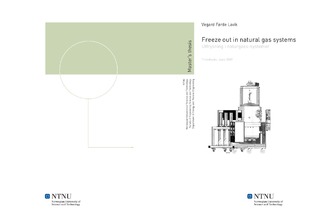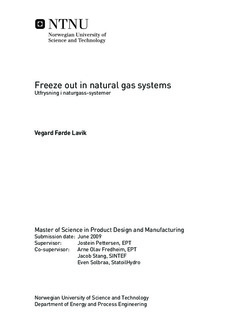| dc.description.abstract | The motivation of the work is to increase the knowledge about thermodynamic modeling of freezeouts in natural gas systems and a deeper understanding of the phase behavior of natural gasmixtures, due to the problems experienced in cryogenic natural gas process-plants. Criticalcomponents in natural gas mixtures introduce a risk of forming a solid coating and plugging theprocess equipment. Hence, it is relevant to examine methane rich binary mixtures containingcomponents with high risk of freezing. Due to their high triple point temperatures, carbon dioxide,benzene and cyclohexane are regarded as the most critical components.The preferred thermodynamic method for modeling the solid fluid system is by describing the fluidphases with a traditionally equation of state in combination with an expression for the solid phasebased on melting and triple point properties. This method is based on the assumption of a purecomponent solid phase, which does not always represent the precipitated substances in natural gassystems. However, it is the situation which represents the highest risk of crystallization at a giventemperature.This study was carried out by applying a simulation tool called NeqSim, where the equation of statemethod is implemented based on the computational algorithms provided by Michelsen andMollerup. To investigate the reliability and accuracy of the equation of state method, it is usedexperimental data from the literature as a foundation and further compared against two existingsimulation tools for freezing point predictions of natural gas mixtures, GPA and HYSYS.The Soave-Redlich-Kwong equation was selected together with classical mixing rules and the use ofbinary interaction parameters. The binary interaction parameters were discovered to be of crucialimportance to the accuracy of the predictions, both for the binary mixtures containing carbondioxide and the heavy hydrocarbons. The model showed promising results for carbon dioxide inmethane rich binary mixtures, after the binary interaction parameter had been optimized. However,the interaction parameter dependency for solid-vapor equilibrium systems was discovered to be lessthan in solid-liquid equilibrium systems. Predictions of freeze outs of heavy hydrocarbons werediscovered to be more challenging, due to numerical problems and a scarce experimental database.One of the main issues concerning the development of reliable thermodynamic models for solid-fluidsystems is the lack of experimental data, which prevents extensive validation of the proposedmodels. The experimental work related to the freeze out rig has mainly involved trouble-shootingand experiments for determining the behavior of the rig. Hence, the experimental focuses were onthe gathering operational experience by running these experiments, and identify the main challengesand the potential areas for improvement. Including a phase study of pure carbon dioxide where thesolid-liquid equilibrium and three-phase point was determined.In order to investigate the binary mixtures of interest, where the composition and the componentexposed to freeze outs is known, the heat loss from the Dewar container and the temperaturedifference between the air bath and the fluid has to be reduced. Hence, the solids will form in thesapphire cell, where the freeze outs can be visually detected. Further, for studying multi-componentmixtures similar to real natural gas mixtures where the composition of the precipitating substance isunknown; a solution for the sampling of the different phases has to be developed, includingextensively testing and validation. | nb_NO |

